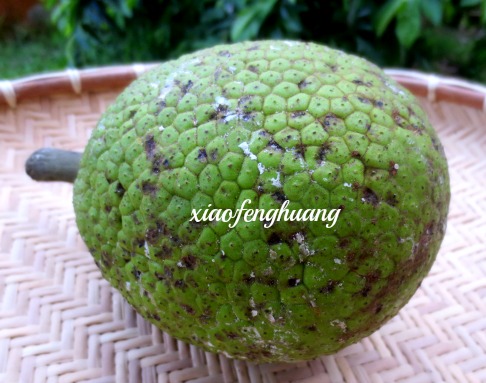Artocarpus is a genus of trees found in South-eastern Asia and in the Pacific.
The fruits in the genus of Artocarpus are terap, tempunik, pingan, bintawak, cempedak, pedadai, nangka and kemangsi. Since we have written a post on the terap and its related fruits like bintawak and pingan, we will focus on campedak and other fruits belonged to the genus of artocarpus and in the same family of Moraceae to which all the figs and jack fruits belong.
One of this fruits is Artocarpus camansi Blanco which is also known as buah pulur(Iban), kamansi (Malay) and breadnut in English. Other names include buah keluih(Malay), Buah Kulru and Kelor(Indonesia).
Is it Breadfruit or Jackfruit? No,it is neither of these two. At first glance, you may think that is either a jackfruit or breadfruit. Really can’t blame anyone for making that mistake. This is breadnut, ancestor of breadfruit, well known for its edible nuts. It can be described as seedy breadfruit. There are people mistaken them for durians.

Both breadnut and cempedak seeds contain high level of protein and low calorie. Pulp of mature fruits are discarded and seeds taken out and boil with a bit of salt. They taste like cempedak seeds and chestnuts too. Young cempedak pulp and seeds are great for cooking curry.

There is another fruit which looks like a mixture of Buah pulur and campedak. Local people call it Durian Cempedak which has no ID yet. It tastes exactly like cempedak with juicy, sweet and fragrant pulp.

Look carefully at their skin. Do they look the same ? The one with spiky skin is called Durian cempedak. It looks like buah pulur but with oblong body shape. It is a new variant of cempedak. Where did it come from? Some said it was the research product of some officers at Tarat area, Serian, Sarawak. Most of us are familiar with cempedak but not this Durian cempedak which is obviously a new fruit without an ID yet.

Let’s look at another look-alike of buah pulur – breadfruit. Breadfruit is not native to Sarawak. It is called buah Sukun. Most of our vendors here in Malaysia sell them as breadfruit fritters together with banana fritters. I prefer to pan-fry them. My late mom used to cook it in sugar syrup and occasionally added coconut milk to the dish. Ripe breadfruit can be eaten raw but be careful of the latex leaking out from the skin.

Another fruit of same genus is the Jackfruit or nangka in Malay. Its ID is Artocarpus Heterophyllus. Nangka should be the biggest fruit found on earth. It can grow up to 20″ long and 12″ across.It is different from cempedak in size and also in its fruit pulp being separated from its seed, unlike the cempedak fruit with pulp sticked to its seed.

Immature nangka fruits and seeds are great for “masak lemak” or curry. Some people, especially old people find nangka fruit a bit tough for them to chew. So before cooking, cut the unripe pulp to smaller pieces.

Ripe nangka fruits are sweet and its pulp do not stick to the seeds. It turns yellow when it is ripe. Malays here would blend the fruits and make cake. Nangka pulp can be cooked in soup together with sweet potatoes.

There is another tiny cempedak which is hardly seen nowadays. It is anout 4-5 cm in length, tastes great like its bigger relative. It is called Cempedak hutan/buah pudu with ID Artocarpus Kemando Miq(as shown below). I used to eat a lot of this fruit during childhood time. Cute-cute cempedak reminds me of my hometown.

Long gone were the days when wild fruits were abundant. Where to find them? We have 24 national parks in Sarawak. May be these are the places to find them in future.
More shoots for ulam to be shared in my upcoming posts.
Copyright claim – Do not crop any pictures from malaysiavegetarianfood.com. Do not share our pictures without any watermarked signature on them. Excerpts from our articles to be credited to malaysiavegetarianfood.com.

